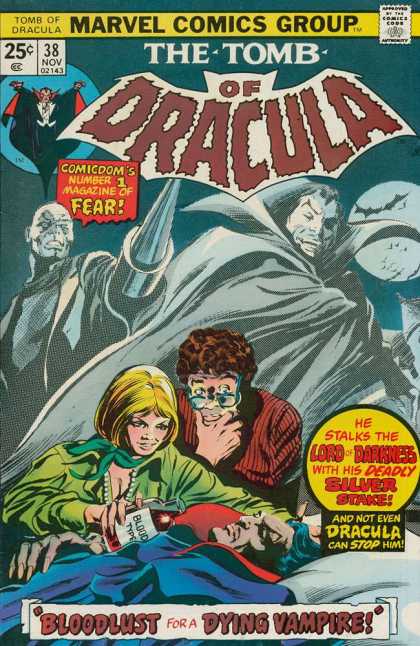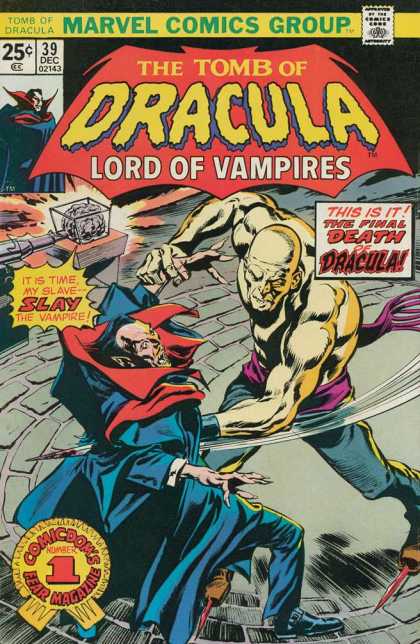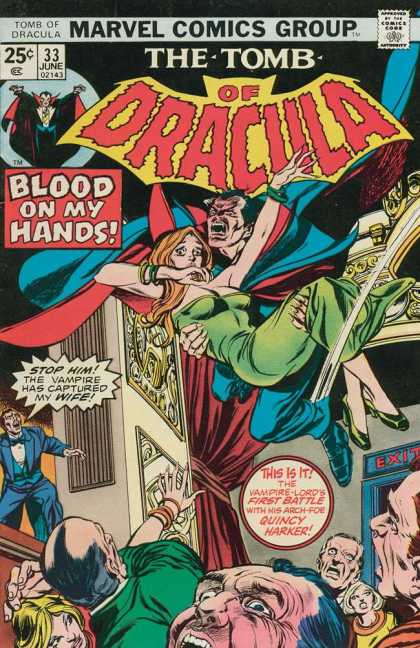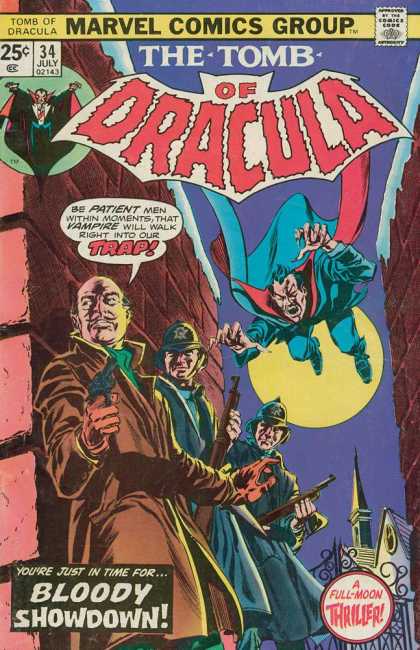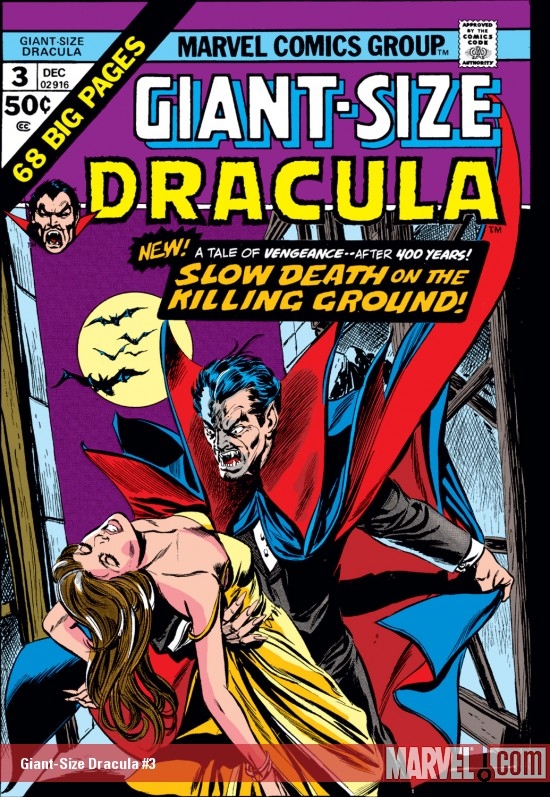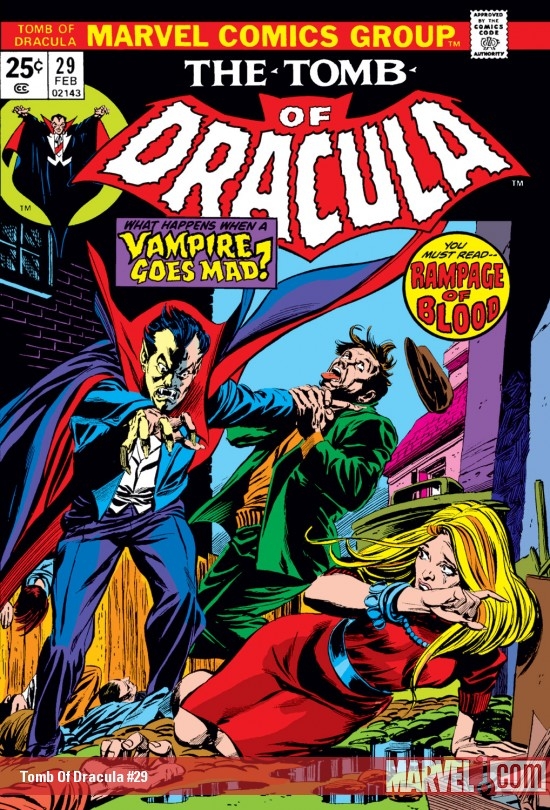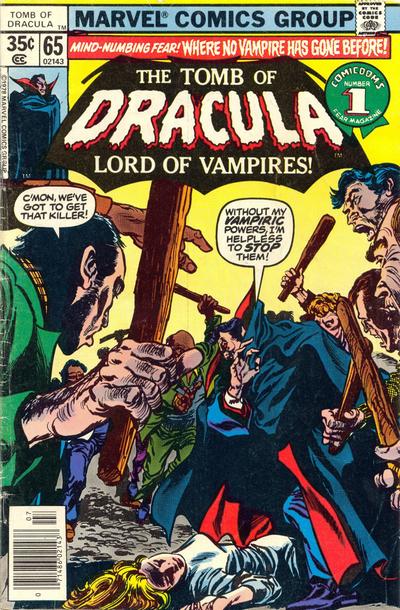
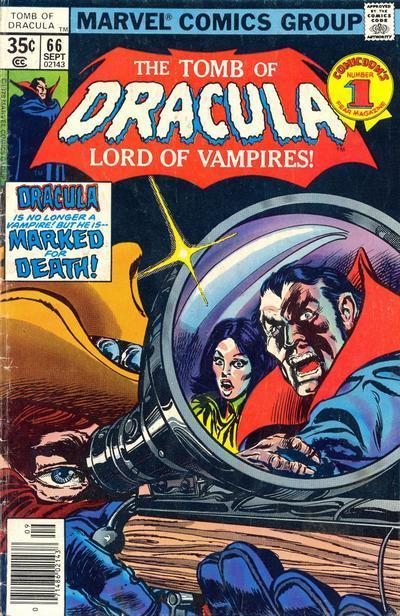 The Tomb of Dracula #65, “Where No Vampire Has Gone Before” starts off with Rachel Van Helsing returning to Quincy Harker, Frank Drake and Janus to tell them that Dracula is no longer a vampire. Frank is skeptical, but Janus and Quincy believe that Satan has stripped him of his supernatural powers and left him in the 20th Century as a mortal man out of time. Quincy and Rachel point out the ethical dilemma they face. They have no right to hunt and kill Dracula if he no longer is a vampire despite the many murders he committed when he was undead. From there the scene switches to a cemetery where the unnamed bounty hunter (who with his Stetson and western dialogue is also a man out of time) digs up a vampire and interrogates him with a fiery cross held to his forehead until the vampire confirms that Dracula is in Boston. We then find Dracula, homeless in an alleyway where he meets a junkie prostitute named Harriet. Dracula innocently (for once) accepts her invitation to go back to her apartment where a couple of her dealer’s hired muscle break in and rough Harriet up for having stolen heroin. Dracula gallantly defends her and though mortal (as he is reminded after he is shot in the shoulder), he is still the fierce warrior of old and easily hurls one of the goons threw a third storey window to the street below. The former vampire is arrested along with Harriet and one of the hired guns, but is later released and declared a hero and has his picture taken by a newspaper photographer. Back on the streets, Dracula finds himself, homeless, penniless and hungry for food for the first time in five hundred years. After running into trouble on the streets again, he resolves to seek out his daughter, Lilith and ask her to turn him into a vampire once more. Meantime, Quincy, Rachel and Frank learn of his recent exploits when the 11:00 news carries the story of an anonymous hero who saved a woman from a mob hit. The next morning, Dracula hijacks a private plane and forces the pilot to take him to New York as he is aware his daughter is living in Greenwich Village currently. A witness to the hijacking recognizes him as the hero seen on television the night before and reports the hijacking to the police. The issue ends with the bounty hunter picking up Dracula’s trail in the police station and realizing his quarry is no longer a vampire. Content that his job has just become easier, the nameless bounty hunter checks out of his hotel and heads for New York.
The Tomb of Dracula #65, “Where No Vampire Has Gone Before” starts off with Rachel Van Helsing returning to Quincy Harker, Frank Drake and Janus to tell them that Dracula is no longer a vampire. Frank is skeptical, but Janus and Quincy believe that Satan has stripped him of his supernatural powers and left him in the 20th Century as a mortal man out of time. Quincy and Rachel point out the ethical dilemma they face. They have no right to hunt and kill Dracula if he no longer is a vampire despite the many murders he committed when he was undead. From there the scene switches to a cemetery where the unnamed bounty hunter (who with his Stetson and western dialogue is also a man out of time) digs up a vampire and interrogates him with a fiery cross held to his forehead until the vampire confirms that Dracula is in Boston. We then find Dracula, homeless in an alleyway where he meets a junkie prostitute named Harriet. Dracula innocently (for once) accepts her invitation to go back to her apartment where a couple of her dealer’s hired muscle break in and rough Harriet up for having stolen heroin. Dracula gallantly defends her and though mortal (as he is reminded after he is shot in the shoulder), he is still the fierce warrior of old and easily hurls one of the goons threw a third storey window to the street below. The former vampire is arrested along with Harriet and one of the hired guns, but is later released and declared a hero and has his picture taken by a newspaper photographer. Back on the streets, Dracula finds himself, homeless, penniless and hungry for food for the first time in five hundred years. After running into trouble on the streets again, he resolves to seek out his daughter, Lilith and ask her to turn him into a vampire once more. Meantime, Quincy, Rachel and Frank learn of his recent exploits when the 11:00 news carries the story of an anonymous hero who saved a woman from a mob hit. The next morning, Dracula hijacks a private plane and forces the pilot to take him to New York as he is aware his daughter is living in Greenwich Village currently. A witness to the hijacking recognizes him as the hero seen on television the night before and reports the hijacking to the police. The issue ends with the bounty hunter picking up Dracula’s trail in the police station and realizing his quarry is no longer a vampire. Content that his job has just become easier, the nameless bounty hunter checks out of his hotel and heads for New York.
Issue #66, “Showdown in Greenwich Village” starts off with Dracula in Greenwich Village at winter. He is cold and lost with no way of finding his daughter. He mugs a husband and wife hoping to find enough money for food and shelter, but is run off by an angry mob. He seeks shelter in a church, but refuses a priest’s offer of help having forsaken God as a child centuries before. He wanders into a disco bar and has just enough money to buy his first hamburger (which he dislikes) when he is picked up by an attractive divorcee named Ann Keats. Dracula humorously chooses the identity of Drake and tells her he is in Greenwich Village looking for his daughter. Ann has friends in the village who trace runaways, but Dracula is unable to provide a photograph or any information on Lilith. He and Ann are accosted by a street gang upon leaving and Dracula easily beats them off, but is stabbed in the process. Dracula goes back to Ann’s apartment and tells her his true identity. While Ann thinks he’s delusional, he places a long distance call to Boston to check on Domini, but refuses to tell his wife where he is. Just then, Francis Leroy Brown, the bounty hunter breaks in and a violent battle ensues that ends in Brown’s death, but not before he shoots Dracula several times. The former vampire slips into unconsciousness as Ann calls for an ambulance. The issue ends with Lilith reading a New York Times article about her father surviving a fatal encounter with Brown as she realizes he is now a mortal and is obviously looking for her.
…
Read More Read More
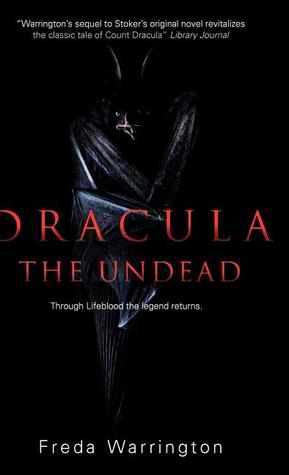
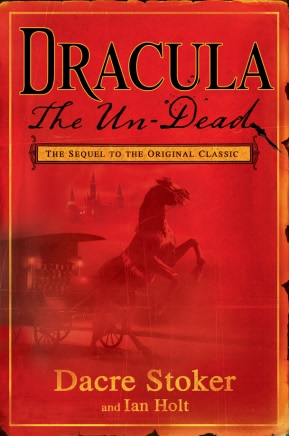 I belong firmly to the camp of Bram Stoker fan that approached Dacre Stoker and Ian Holt’s Dracula the Un-Dead with great anticipation and left disappointed. Well, actually appalled might be a more apt description of the reading experience. Had I not had my jaws wired shut at the time I read the book, I would have described myself as speechless. Severn House, a small press that has been kicking around for at least forty years when they took over Tom Stacey’s imprint, decided to capitalize on the attendant hoopla of a Stoker descendant co-writing a sequel to reprint an earlier literary sequel with very nearly the same title.
I belong firmly to the camp of Bram Stoker fan that approached Dacre Stoker and Ian Holt’s Dracula the Un-Dead with great anticipation and left disappointed. Well, actually appalled might be a more apt description of the reading experience. Had I not had my jaws wired shut at the time I read the book, I would have described myself as speechless. Severn House, a small press that has been kicking around for at least forty years when they took over Tom Stacey’s imprint, decided to capitalize on the attendant hoopla of a Stoker descendant co-writing a sequel to reprint an earlier literary sequel with very nearly the same title.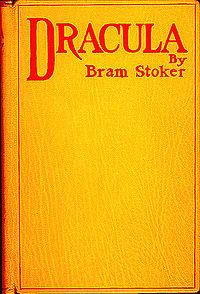
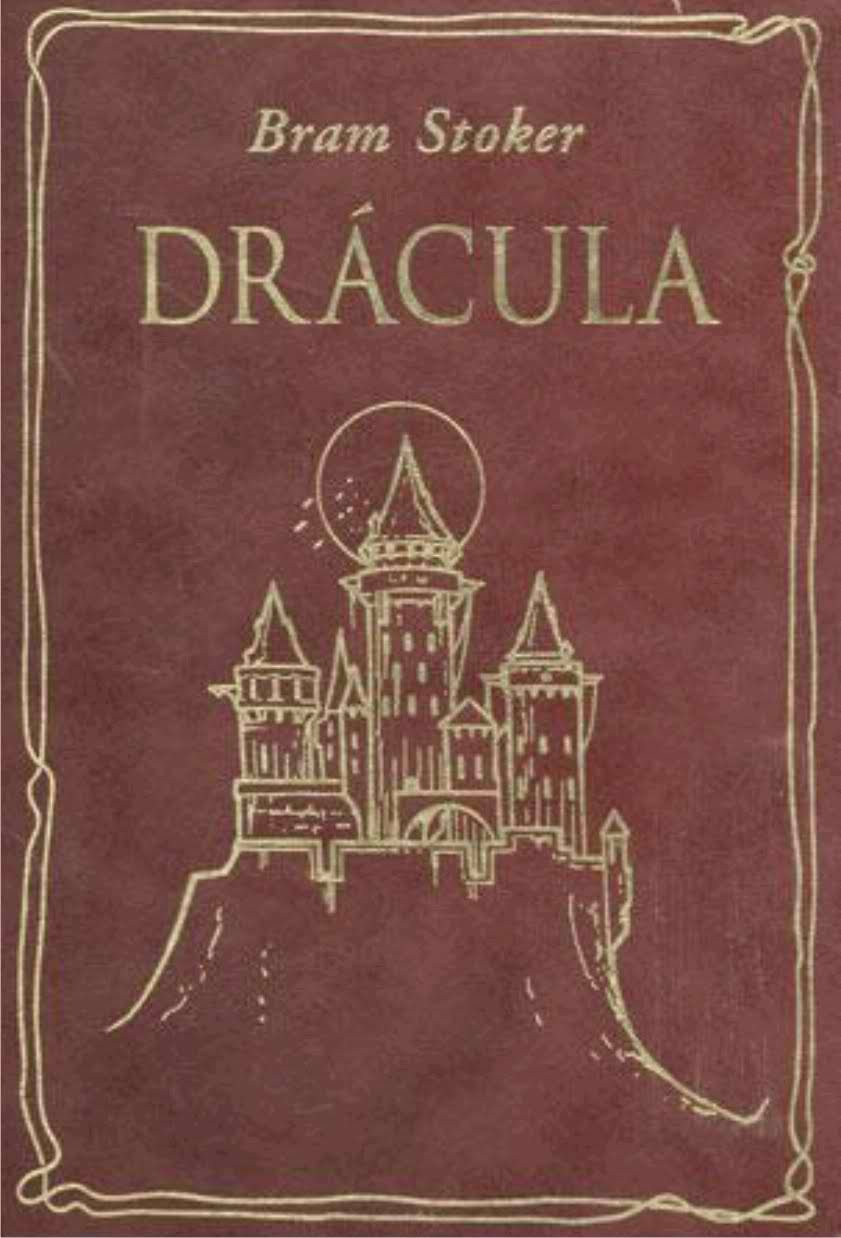


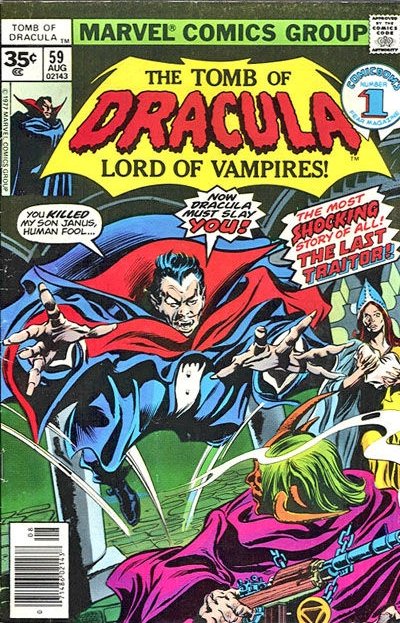
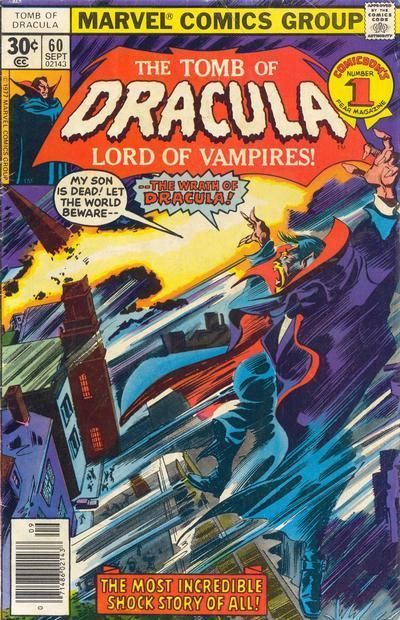
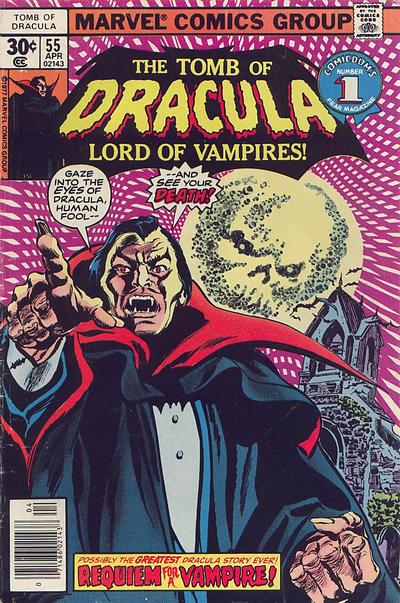
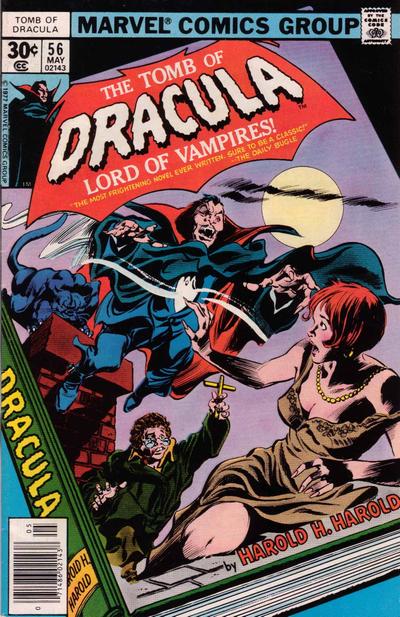 #56, “The Vampire Conspiracy” is the title of Harold’s fictionalized account of his encounters with Dracula. This is really just a humorous filler issue which neatly summarizes the Boston-based storyline thus far and wrings some humor out of the contrast between Harold’s narration (where he depicts himself as capable, heroic, and distinctly Sherlockian) and the reader’s recollection of what has occurred in the narrative up to this point. It is interesting to note that Harold portrays Rachel and Aurora as helpless damsels in distress in a fashion that is very familiar to those who grew up on a steady diet of Universal and Hammer horror. Most intriguing is a purely fictionalized encounter between Dracula and Satan who appears in the form of a black panther. While no such event has occurred, it does prefigure the direction Wolfman is about to take with the storyline in coming months. As it is, the issue remains a diverting time-filler.
#56, “The Vampire Conspiracy” is the title of Harold’s fictionalized account of his encounters with Dracula. This is really just a humorous filler issue which neatly summarizes the Boston-based storyline thus far and wrings some humor out of the contrast between Harold’s narration (where he depicts himself as capable, heroic, and distinctly Sherlockian) and the reader’s recollection of what has occurred in the narrative up to this point. It is interesting to note that Harold portrays Rachel and Aurora as helpless damsels in distress in a fashion that is very familiar to those who grew up on a steady diet of Universal and Hammer horror. Most intriguing is a purely fictionalized encounter between Dracula and Satan who appears in the form of a black panther. While no such event has occurred, it does prefigure the direction Wolfman is about to take with the storyline in coming months. As it is, the issue remains a diverting time-filler.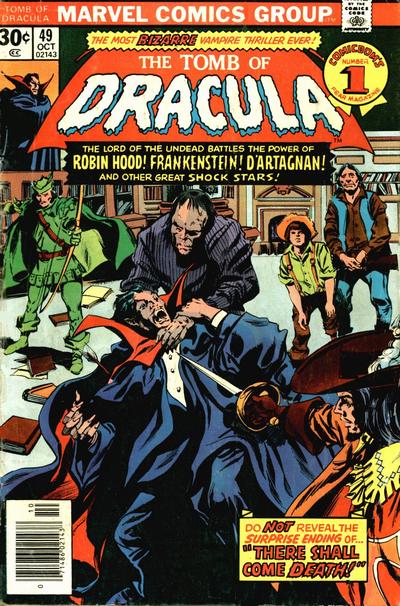
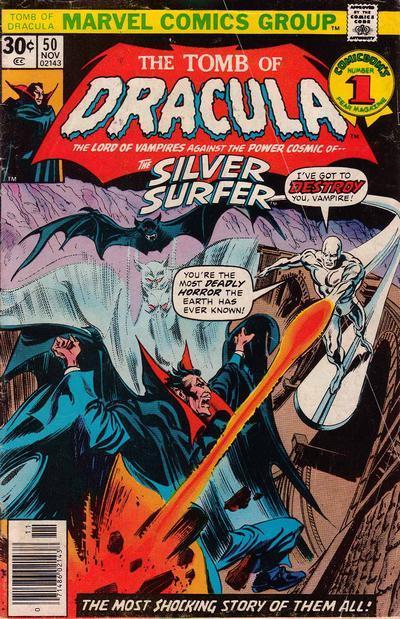
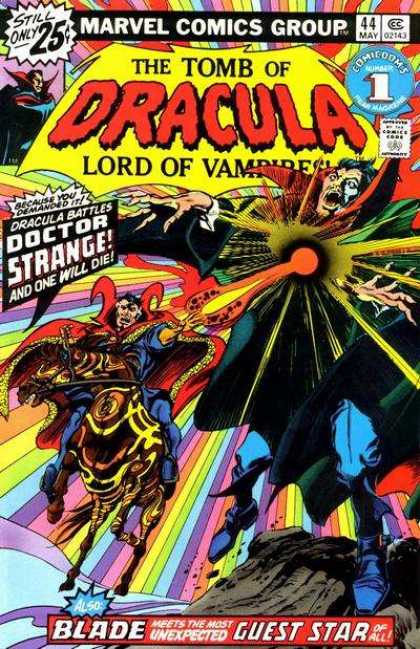
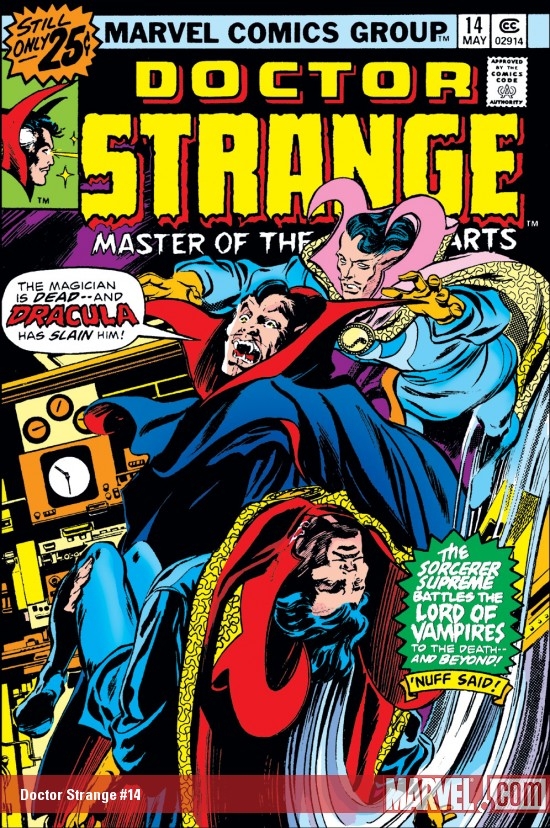 From there, we move to the much more interesting subplot involving the white-haired vampire who is being sought by both Blade and Hannibal King. The actual conflict between Dracula and Dr. Strange comes off rather well with the sorcerer tracking the vampire to his coffin and entering an astral battle with the vampire in 15th Century Wallachia. Unsurprisingly, Strange underestimates the vampire’s hypnotic powers and is attacked and bitten by Dracula. The issue’s real climax sees Blade and Hannibal King meeting for the first time on the trail of the white-haired vampire who ruined both of their lives.
From there, we move to the much more interesting subplot involving the white-haired vampire who is being sought by both Blade and Hannibal King. The actual conflict between Dracula and Dr. Strange comes off rather well with the sorcerer tracking the vampire to his coffin and entering an astral battle with the vampire in 15th Century Wallachia. Unsurprisingly, Strange underestimates the vampire’s hypnotic powers and is attacked and bitten by Dracula. The issue’s real climax sees Blade and Hannibal King meeting for the first time on the trail of the white-haired vampire who ruined both of their lives.